
What is Jaw Surgery or Orthognathic Surgery?
By Dr. Tyler Coles – Premier Orthodontics
Table of Contents
Jaw surgery, also known as orthognathic surgery or corrective jaw surgery, corrects misalignment of the jaw bones. It also helps with activities like chewing and swallowing. Orthognathic surgery can even improve your profile and facial appearance and change your jawline.
Jaw surgery is usually done in combination with braces, Invisalign, or some other orthodontic procedure. Jaw surgery and braces is a great option for patients who have significant bite problems that may not be able to be fixed with orthodontics alone.
But you don’t have to worry about making this decision on your own. Orthodontists will work with an oral surgeon to best determine the treatment plan that is right for each patient. The orthodontist generally handles the braces or Invisalign portion, while the oral surgeon performs the operation.
Why Does Someone Need Corrective Jaw Surgery or Orthognathic Surgery?
Orthognathic jaw surgery may help to:
- Correct functional bite problems that make biting and chewing difficult or painful.
- Improve swallowing and speech problems due to jaw misalignment.
- Improve the bite to avoid excessive erosion on the teeth due to an unbalanced bite.
- Correct facial imbalances, including a retrusive lower jaw, retrusive upper jaw, or a protrusive lower jaw.
- Help improve breathing and symptoms related to sleep apnea.
What are the Pros and Cons of Orthognathic Surgery?
Jaw surgery is a very involved operation, but there are many benefits to having it done:
- Improved appearance of your profile post-surgery
- Improved biting, chewing and swallowing.
- Possible improvements of breathing and major symptoms related to sleep apnea.
- Possible improvements in speech impairments.
- Correction of bite problems that can’t be fixed with orthodontics alone.

Due to the extensive nature of the surgery, there are some risks and drawbacks that one should be aware of. It is generally safe when performed by an experienced oral surgeon; however, like all surgeries, there are risks involved.
Some general risks of jaw surgery may include:
- Infection
- Nerve injury
- Jaw fracture
- Some relapse of the jaw position
- Problems with bite fit
- Jaw joint pain
After surgery, you will likely have:
- Pain and swelling in the surgical areas
- A diet consisting of soft foods during the initial healing period
- A brief time of adjustment to a new facial appearance
Additionally, the cost involved for jaw surgery can be high, especially for those without medical insurance coverage.
What Are the Different Types of Corrective Jaw Surgeries or Orthognathic Surgeries?
We will describe three common types of jaw surgeries:
- Underbite Jaw Surgery
- Overbite Jaw Surgery
- Open Bite Jaw Surgery
Underbite Jaw Surgeries
Maxillary Advancement
If a patient has an underbite with a retrusive upper jaw (meaning too far back), but the lower jaw is well positioned, a maxillary advancement may be the best treatment option. As shown in the animation below, a maxillary advancement involves moving the upper jaw forward to correct the underbite and improve the patient’s profile.
Once the jaw is set in its new position, it is fixed in place with titanium screws and metal plates.
Mandibular Setback
If a patient has an underbite with a protrusive lower jaw (meaning too far forward) but the upper jaw is well positioned, a mandibular setback may be the best treatment option. As shown in the animation below, a mandibular setback involves moving the lower jaw back to correct the underbite and improve the patient’s profile.
Once the jaw is set in its new position, it is fixed in place with titanium screws and metal plates.
Maxillary Advancement With Mandibular Setback
If a patient has a severe underbite and a combination of retrusion of the upper jaw and a protrusive lower jaw, a “double jaw” surgery may be needed, meaning that surgery will be done on both the upper and lower jaws.
A double jaw surgery includes moving the upper jaw forward and the lower jaw back;the technical term for this is a maxillary advancement with mandibular setback. This is best understood by watching the animation below.
Overbite Jaw Surgery
Mandibular Advancement
If a patient has a severe overbite and a retrusive lower jaw, then a mandibular advancement may be the best treatment option.
As shown in the animation below, a mandibular advancement involves surgical movement of the lower jaw forward to correct the overbite and improve the patient’s profile.
Once the jaw is set in its new position, it is fixed in place with titanium screws and metal plates.
Orthognathic Jaw Surgery Before and After
Many of our patients have chosen a combination of braces and corrective jaw surgery. Here are a few examples below:
Example 1: Treated with a maxillary advancement and mandibular setback due to a retrusive upper jaw and protrusive lower jaw.
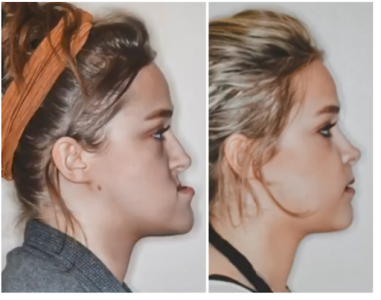
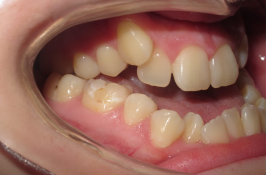

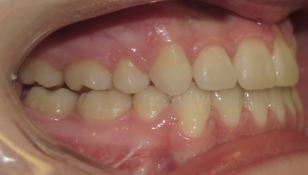
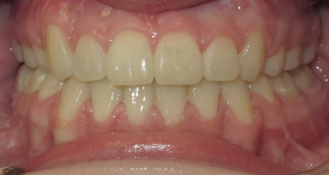
Example 2: Treated with a maxillary advancement and mandibular setback due to a retrusive upper jaw and protrusive lower jaw.



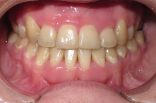
Example 3: Treated with a maxillary advancement due to a retrusive upper jaw.

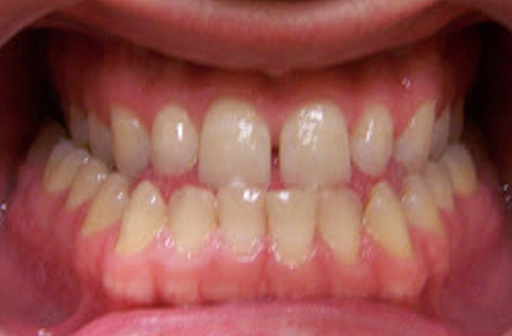


How does Jaw Surgery work? What is the Timeline?
In most cases, an orthodontist places braces on your teeth before surgery. Braces are usually on for 12 to 18 months before surgery to level and align your teeth in preparation for surgery. In some patients, removal of teeth and space closure may also be needed prior to surgery.
Your orthodontist and oral and maxillofacial surgeon work together to develop your treatment plan. X-rays, pictures and models of your teeth are also part of the planning for your jaw surgery, and will help build an expected timeline for recovery.

Jaw surgery is performed by an oral surgeon. This is usually done under general anesthesia in the hospital. Most jaw surgeries will require a two- to four-day stay in the hospital for recovery.
During the surgical procedure, the surgeon makes cuts in the jawbones and moves them into the correct position. Once your jaw movement is completed, tiny bone plates and screws are used to secure the bones into the correct position. The patient will be under general anesthesia during this entire process. These screws and plates will integrate into the bone and will remain in the jaw indefinitely.

After initial jaw healing — about six weeks — your orthodontist will continue your orthodontic treatment. It may take 6-12 months of braces treatment after surgery to get your teeth into the final and most optimized position. Once the braces are removed, retainers will be needed to maintain the teeth and bite position.
In total, most patients will be in braces at least two years, with about two months in the middle of treatment to receive the jaw surgery.
What is the Cost of Jaw Surgery?
If you have medical insurance, orthognathic surgery may be covered in some cases. This varies greatly from one insurance company to the next. Some consider jaw surgery cosmetic and may not cover the treatment. Your oral surgeon will be able to better advise you on whether your insurance would cover orthognathic jaw surgery.
The cost of jaw surgery when paid out of pocket and without insurance typically ranges between $20,000-$40,000
Can I Be Treated Without Corrective Jaw Surgery?
For those patients with minor underbite and overbites, there are many treatment options involving braces or Invisalign that may not require jaw surgery. If there is a significant bite problem that is beyond the scope of orthodontics alone, then surgery may be the best option.
Your orthodontist would be the best one to consult with to determine if surgery is needed in your specific case.
Consultation for Braces and Jaw Surgery in Phoenix, Chandler, Maricopa, and Casa Grande
Premier Orthodontics has 6 locations providing braces and Invisalign in Phoenix, Chandler, Gilbert, Maricopa, Casa Grande, and Glendale as well as the surrounding areas.
Schedule your free consultation for braces or read our comprehensive guide to the cost of braces . (We are very transparent about our process and our pricing, as you’ll see in this guide.)
Schedule a Free Braces Consultation For You or Your Child
Thinking about getting started with braces?
You can schedule a 100% free consultation and find out if clear braces the best choice for you.
Whether you’re thinking about braces for kids, braces for an adult, or even Invisalign, we’ve got you covered!
Click below to learn how you can get started with braces for as low as $89/month.

